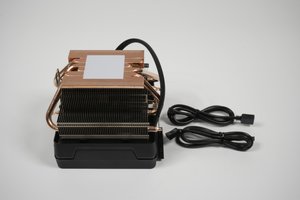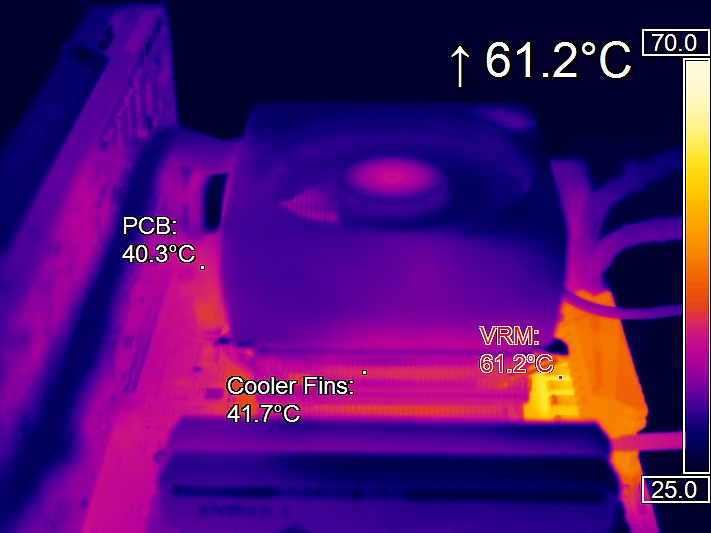AMD Ryzen 7 2700X Review: Redefining Ryzen
Why you can trust Tom's Hardware
Thermals And Noise
The Wraith Prism
Ryzen 7 2700X's Wraith Prism thermal solution is a large, high-finned cooler with four flattened heat pipes and a plate behind them for stabilization. The heat sink's entire contact surface is thus made of copper. Its fins are arranged in such a way that the exhaust air is focused toward the memory and I/O shield.


The fastening clamp is a big disadvantage of this large cooler, which takes us back to the old Athlon XP days. Even at maximum load on all cores in the stress test, the CPU only reaches a maximum temperature of 82.8°C (corrected value), so it remains below the thermal throttle threshold. The cooler handles the 105 watts easily. You can expect peaks up to 70°C and a little above, depending on the motherboard's predefined fan curve.
The cooler is loud and emits 44 dB(A) under load (50 cm distance, 45° diagonal) when the fan is spinning at 2600-2700 RPM. The fan can even be a bit noisy even when the system is idling on the Windows desktop. Unfortunately, the fan adjusts much too rapidly as the cooler reacts to short-term temperature jumps.
We see the result in the narrow-band frequency spectrum of the motor noise, which shifts back and forth between approx. 240 and 300 Hz. The fan generates almost 39 dB(A) at idle, which isn't necessary. It helps if adjust the fan curve to a fixed speed of at least 1400 RPM if the processor is under 60°C. However, you'll have to experiment because each case will require different settings.
AMD has made good progress with XFR2 and the powerful cooling finally pays off in terms of performance. The power consumption remains largely the same and you get a nice clock rate increase, but we don't like the unnecessary noise levels or the fiddly mounting mechanism.
MORE: Best CPUs
MORE: Intel & AMD Processor Hierarchy
Get Tom's Hardware's best news and in-depth reviews, straight to your inbox.
MORE: All CPUs Content

Paul Alcorn is the Editor-in-Chief for Tom's Hardware US. He also writes news and reviews on CPUs, storage, and enterprise hardware.
-
Ninjawithagun Once again, Tom's provides an incorrect comparison in this review. Intel's 8700K is comparable to the 2600 or 2600X and NOT the 2700 or 2700X. Just count the number of cores and threads and one should be able to figure that out O.oReply
Whine all you want. Just because you down vote me only means you don't know how to read or count :P -
Sakkura Reply20899022 said:Once again, Tom's provides an incorrect comparison in this review. Intel's 8700K is comparable to the 2600 or 2600X and NOT the 2700 or 2700X. Just count the number of cores and threads and one should be able to figure that out O.o
The 2700X costs $329, the 8700K costs $359. It is a very reasonable comparison to make. -
justin.m.beauvais It sure is nice to see an AMD chip up there in the thick of it with Intel's best offerings. Competition has finally officially returned. I'm impressed that AMD gained so much ground and managed to make the price more competitive than the 1800x was. It is slightly disappointing that overclocking remains less impressive than the Intel offerings, but everything else sort of makes up for that.Reply
I didn't feel like AMD was quite "there" yet with the 1000 Ryzens, but with the 2000 series I feel like we can finally say that they have arrived. -
Ninjawithagun Reply20899035 said:20899022 said:Once again, Tom's provides an incorrect comparison in this review. Intel's 8700K is comparable to the 2600 or 2600X and NOT the 2700 or 2700X. Just count the number of cores and threads and one should be able to figure that out O.o
The 2700X costs $329, the 8700K costs $359. It is a very reasonable comparison to make.
Incorrect. It has nothing to do with price. Comparing like CPU architectures is the only logical course of action. 6 core/12 thread vs 8 core/16 thread makes no sense. Comparing the Intel 8700K 6 core/12 thread @ $347 to the AMD 2600X 6 core/12 thread @ $229.99 makes the most sense here. Once the proper math is done, AMD destroys Intel in performance vs. cost, especially when you game at any resolution higher than 1080P. The GPU becomes the bottleneck at that point, negating any IPC benefits of the Intel CPUs. I know this how? Simple. I also own a 8700K gaming PC ;-)
Once again, whine all you want. Just because you down vote me only means you don't know how to read or count :P -
bfwhsm Now, do the tests again with meltdown/spectre applied on intel cpus, as you should.Reply
And you will see a VERY different story, with 2700k destroying 8700k in almost every measure).
(check out anandtech's review to get an idea) -
Ninjawithagun Reply20899131 said:Now, do the tests again with meltdown/spectre applied on intel cpus, as you should.
And you will see a VERY different story, with 2700k destroying 8700k in almost every measure).
(check out anandtech's review to get an idea)
I will definitely check out that review as well. Thanks bfwhsm! -
tripleX Reply20899131 said:Now, do the tests again with meltdown/spectre applied on intel cpus, as you should.
And you will see a VERY different story, with 2700k destroying 8700k in almost every measure).
(check out anandtech's review to get an idea)
Maybe you should read the comments on the AnandTech article. They all point out that the test results don't match any other site's results. -
Sakkura Reply20899157 said:20899131 said:Now, do the tests again with meltdown/spectre applied on intel cpus, as you should.
And you will see a VERY different story, with 2700k destroying 8700k in almost every measure).
(check out anandtech's review to get an idea)
Maybe you should read the comments on the AnandTech article. They all point out that the test results don't match any other site's results.
... because of the different testing procedure that he just referred to.
